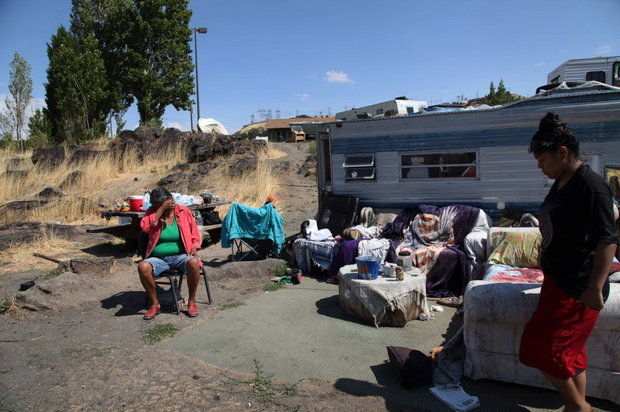forum
library
tutorial
contact

Empty Promises to
Displaced Tribal Fishermen
by Roberta Ulrich
The Oregonian, November 15, 2014
|
the film forum library tutorial contact |

|
Empty Promises to
by Roberta Ulrich
|
 Ninety miles east of Portland, the Dalles Dam looms over the Columbia River and the surrounding countryside, a concrete monument to engineering and construction. It does what it was built to do -- provide electric power to the region, offer passage for commerce, help control flooding. Less than a mile downstream are some of its other effects, less benign, still unmitigated after more than half a century.
Ninety miles east of Portland, the Dalles Dam looms over the Columbia River and the surrounding countryside, a concrete monument to engineering and construction. It does what it was built to do -- provide electric power to the region, offer passage for commerce, help control flooding. Less than a mile downstream are some of its other effects, less benign, still unmitigated after more than half a century.
There, at the Lone Pine Indian "in lieu" fishing site, dozens of cars, trucks, trailers, tents and shacks are jammed together fender-to-bumper-to-wall on a patch of rock and bunch grass above the river. Living there are the people -- and their children and grandchildren -- flooded from their treaty-guaranteed fishing sites, campgrounds and homes by Columbia River dams starting in the 1930s. Running water and electricity serve only a restroom and fish cleaning stations. There, in the shadow of one of the mightiest producers of electricity in the region, residents depend on portable generators or go without lights and appliances.
Lone Pine is the most crowded but there are half a dozen other Indian fishing sites along the river where the displaced fishing people either camp through the fishing seasons or live permanently. Their housing is still a contentious issue after three quarters of a century.
A bit of history here: In 1939, the U.S. Army Corps of Engineers, builder of Bonneville Dam, promised to replace two dozen Indian fishing sites flooded by that dam with six new sites totaling 400 acres. More than 30 years later the corps had provided five sites totaling 40 acres. The seven-acre Lone Pine site was a substitute for the 200-acre Spearfish (or Big Eddy) location, which instead became a footing for the Dalles Dam.
When the Dalles Dam was built, the corps replaced the premier fishing village of Celilo with a smaller village across railroad tracks and a freeway from the river. There was no compensation for other living sites. Nor was there any compensation to the Indians displaced by John Day Dam, although Indians lived and fished along the riverbank on both the north and south shores. During the time the government found barrier after barrier to developing new fishing sites or replacing Indian homes, it paid $3 million to move the town of Arlington (population 643) to higher ground plus $500,000 for a new school. It paid $1.5 million to move Boardman businesses and homes and $360,000 to move parts of Roosevelt, Washington.
In 1988, new legislation resulted in bringing the number of Indian fishing and boat launching sites on the 140 miles of reservoirs between Bonneville and McNary dams to 29, totaling 718 acres. Only 189 acres are on the Bonneville pool. As the work was being completed in 2011, the corps prepared to close the project. But the tribes that fish that part of the Columbia -- Yakama, Warm Springs, Umatilla and Nez Perce -- objected to ending the project without the creation of additional housing.
In response, the corps commissioned a "fact-finding review" as a basis for determining whether the government has a remaining obligation. If top officials in Washington agree that an obligation remains, the corps will seek funds and authority from Congress to build more housing for the fishing families.
Meanwhile, as winter comes on, the winds in the gorge will become colder and stronger and the flimsy housing at Lone Pine and other sites will offer minimal protection. Alternate housing will also be harder to find. Housing for low-income people is a problem throughout the Columbia River Gorge as tribal and non-tribal fishermen have flocked to the river in large numbers. Increased recreation opportunities draw many more people. Burgeoning demand for second homes adds to the upward pressure on home prices and rents. So the Indians cling to their crowded bits of rock and sand. Some still cling to the hope their lost homes will be replaced.
Enough evidence exists in public records to justify speedier action toward that end than bureaucratic processes allow. The Oregon and Washington congressional delegations should introduce legislation providing authorization and money allowing the corps to finish righting this decades-old wrong.
learn more on topics covered in the film
see the video
read the script
learn the songs
discussion forum
